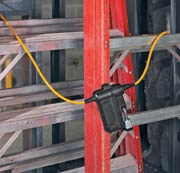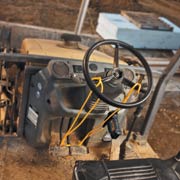Site Security: Wireless
Technology to the Rescue
 |
Cell phone technology
Enter the technology of cell phones. Love them or hate them, cell phones keep
us connected wherever we are. How about a security system that works with
the same wireless technology? DeWalt has just brought it to market under the
name SiteLock.
Let's start with a 12-foot stainless steel locking cable, which we would usually
tie down with a padlock. Of course this can be cut in two seconds with a good
bolt cutter. But this time, rather than using a padlock, it is locked with
a transmitter that will instantly report to the base controller unit when
the cable is cut, or its absence will be detected and reported if it is destroyed.
This can be used to attach ladders, tools, equipment and even the steering
wheel to the pedals of that backhoe or front loader.
 |
The security cable lock
serves as a control system against honest people, and a real alarm system
against dishonest people.
We have lots of containers on construction sites as well as storage trailers.
Once again, hardwired security is complicated and easy to damage accidentally.
How about a simple little box the size of a cell phone that is either magnetically
attached to the container, or bolted on through four bolt holes? Move the
container more than the vibration setting you have adjusted on the Container
Sensor, and it instantly reports in to the base controller unit. Equipment
or products that cannot be locked down and might be lifted and towed away
can be protected with this movement sensor.
Now, any decent security system would have window and door opening sensors
as well as motion sensors for indoor spaces. In DeWalt's SiteLock system,
these are wireless as well, as is the Key Chain Remote. In fact, you can have
up to six key chain remotes so that various people can lock down or open up
the site each day.
All of these devices report in to the site's Base Unit, which can control
up to 48 sensors and six key chain remotes - anything within a 2,000-foot
"open range" distance. In reality, few sites have "open range"
conditions so the signal strength of each device must be checked as it is
installed. The beauty is that the whole system is a two-way communications
system, so the base will, at all times, monitor the signal strength of every
sensor and let you know if something is out of range, or even has a low battery.
 |
The
base unit
The base is a relatively small unit that is mobile but can be locked down
to a mounting bracket. The base unit not only has two-way communication with
every one of the sensors and the activation keypads, but it uses a built-in
motion sensor to protect itself.
When one of the sensors are tripped, the base unit emits a loud siren and
a strobe light to chase the vandals off, but it also uses cell phone technology
to send out a notice of intrusion, all in less than one second. Now there
are two options. This notice can simply go out to the contractor's cell phone
for self monitoring, or it can go to a central monitoring operation that specializes
in the DeWalt system and they, in turn, can more efficiently run down someone
responsible for the site - even send in the police where that is permitted.
Just how reliable is all the wireless communication between the sensors and
the base and between the base and the monitoring support? We all know that
ordinary cell phones often get into frequency problems and experience drop-out.
DeWalt claims that the SiteLock system is highly reliable and virtually immune
to background RF noise by using what they call "900 MHz frequency hopping
spread spectrum communications with massive redundancy." This is important
because reliable communications with no wires to cut is the core of their
security.
 |
DeWalt
explains the technology
Spread spectrum modulation transmits RF transmitter data over many separate
radio frequencies preventing interference or jamming at any one frequency.
"Frequency hopping" is a technical description of the type of Spread
Spectrum where the transmitter is constantly and quickly changing its radio
frequency.
The SiteLock system receivers are designed to "know" where to "hop"
to find valid transmissions. Frequency-hopping spread spectrum works somewhat
like sending individual words of a secret message over the entire range of
an FM radio dial at very high speed.
If there is not good cell phone signal strength at the construction site,
then a landline telephone line can be connected to the base controller unit
for the notification signals.
When you look at this system as a whole, going wireless means you can quickly
set up or continually change a complete site security system without hiring
security installers. This allows you to adapt the sensor placement from day
to day as site conditions change, material is delivered or even installed.
Indoor motion sensors can be quickly installed inside the house every night
if you wished, and moved out of the way for construction during the day. A
vibration sensor could be slid into the packaging of the stack of windows
not yet installed. With 48 sensors possible, you can protect a large site,
or trim it down for a single renovation. It could be used to extend the coverage
and efficiency of human patrollers.
For once, someone is offering a security system that is adapted for constantly
changing construction needs, rather than compromising on security to avoid
constantly rewiring standard security systems. HB


